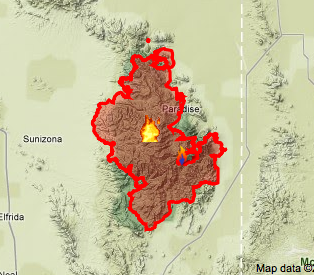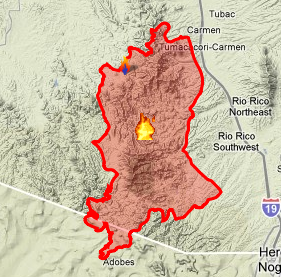Քարտեզներ / պարունակություն % թարմացվել է: 16 Հունիս
Քանի որ հուլիսը մոտենում է, ես անհամբեր սպասում եմ Լեպիդոպտերիստների Խաղաղօվկիանոսյան ափի հանդիպմանը’ Հասարակություն. Այս տարի այն տեղի կունենա Պրեսկոտ Արիզոնայում, մոտ 2 ժամեր Ֆենիքսից հյուսիս. Եվ այս պահի դրությամբ այն Արիզոնայի սակավաթիվ վայրերից մեկն է ոչ կրակի վրա. Համոզված եմ, որ դուք բոլորդ լսել եք զանգվածային հրդեհների մասին հենց հիմա, բայց ահա թարմացում մի փոքր կենսաբանական տեսանկյունից. Ամենակարևորը, մենք բոլորս պետք է երախտապարտ լինենք հրշեջներին, ովքեր վտանգում են իրենց կյանքը այս անտառային հրդեհների դեմ պայքարելու համար.
Ինչ-ինչ պատճառներով ես չկարողացա կապել ինտերակտիվ քարտեզներին անմիջապես InciWeb կայքից, բայց խնդրում ենք հետևել հղումներին՝ հետագա ուսումնասիրության համար. Մինչդեռ Google Maps-ում կան այս հրդեհների լավ ինտերակտիվ քարտեզներ, նրանք մի քանի օրական են. Ստորև ներկայացված են ավելի քիչ քարտեզների էկրանային պատկերներ 12 ժամեր.
Հրդեհ 1: The biggest one, The Wallow Fire is 20% 29% contained, human caused and has been burning for over 15 օր. I had been hoping to go collecting around the town of Greer and Alpine, but both have fire quickly encroaching. The White Mountains region of Arizona is a fascinating blend zone between southern desert species and Rocky Mountain ones – the rare moth I was hoping to find here, Alexicles aspersa, will likely evade me yet again this year.
Հրդեհ 2: Horseshoe 2 Հրդեհ. 60% contained, human caused, burning for over 37 օր. This fire has consumed nearly the entirety of the Chiricahua Mountains, save for the famous Southwestern Research Station. The news report is a few weeks old, but thankfully I doubt anything has happened to the station since that would have made headlines quickly (at least in the biology community). Aside from notable endangered species (2), the upper-most peaks of this range have recently revealed handfuls of impressively large and beautiful new species of Lepidoptera: Lithophane leeae, Chiricahua lichenaria (new genus, նոր տեսակներ), Eupithica տեսակներ, Grammia allectans (old sp, but only known in this region) – amongst other yet to be named ones! It is hypothesized that since only the highest peaks are revealing these impressive species that they are attenuated populations from the adjacent mountains in northern Mexico. Since every high peak has now burned, it is likely that some of these may now be extirpated from the US.
Հրդեհ 3: Murphy Complex Fire. 90% contained, human caused, burning for 15 օր. This fire has burned some of the most famous collecting sites in all of Arizona – ներառյալ Pena Blanca, Sycamore Canyon and California Gulch. The birders know Cal Gulch because it is one of the only US locations for the five-striped sparrow իսկ elegant trogon, which may not be so happy now.
Without getting too deep into the politics and controversy surrounding wildfire, for the most part nature has evolved to cope with these events. While current management policies may be flawed, there will be a fascinating succession of species over the coming decades. Each location will have burned differently and will experience different fluctuations of species as plants recolonize. I am most concerned about the Chiricahua fire since all of the high elevation areas have burned, leaving zero areas of similar habitat for recolonization events. Hopefully many of these newer species range into Mexico, but the possibility of losing an unknown endemic still exists. Alternatively, these fires could be a positive event and lead to stronger populations of some species or even colonization by other unknown Mexican animals. More likely than not each species will respond different and it will be fascinating to monitor the progress over the long recovery.




Good to hear someone raise the topic of habitat change and possible new species in the Chiricahua Mountains. While it may not be pretty, habitat reorganization due to fire does not equate to the elimination of habitat.